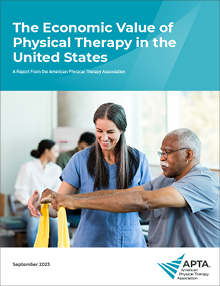By using this site, you are consenting to our use of cookies. To find out more visit our privacy policy.
The American Physical Therapy Association engaged Nous, an international management consulting firm, to examine the costs and benefits of eight condition-based physical therapist services, each of which was chosen based on the prevalence of the condition and its associated level of health care spending across the United States.
"The Economic Value of Physical Therapy in the United States" presents the results of this analysis by synthesizing the available clinical research on services delivered for each of the eight conditions and drawing comparisons between physical therapist services and non-physical therapist treatments, based on the costs associated with providing care and the benefits generated within the American health care system.
Physical therapy was found to have a net economic benefit over the alternative treatment for each of the conditions.
Net Benefit Calculations
To create a robust basis for all claims of cost-effectiveness, we took a conservative approach to assess the net benefit of each course of care. Potential indirect, or flow-on, benefits, such as marginal productivity increases, were therefore left out of the calculations. The cost of care delivered comprised the cost of the services rendered as well as the potential cost of the patient's time spent attending physical therapy sessions (including estimated travel time to and from appointments) and, when applicable, performing their prescribed exercises.
The results show that the suite of physical therapist services investigated were clinically effective and delivered net economic benefits, with improvements in patients' quality of life exceeding the net cost of the care delivered.
The Eight Conditions Analyzed
The eight conditions analyzed for this report, and the average net benefit of physical therapist services per episode of care, are summarized below.
| Condition | Average Net Benefit |
| Osteoarthritis of the knee | $13,981 |
| Carpal tunnel syndrome | $39,533 |
| Acute low back pain | $4,160 |
| Stress urinary incontinence | $10,129 |
| Tennis elbow | $10,739 |
| Vascular claudication | $24,125 |
| Falls prevention | $2,144 |
| Cancer rehabilitation | $3,514 |
The results in this report demonstrate that, where medically appropriate, more widespread use of the selected physical therapist services would deliver both health and economic benefits to patients and to the U.S. health care system.
A wider range of conditions initially was considered and then narrowed down to the eight in the report, based on specific economic evaluation criteria applied to the currently available research evidence base. As stronger evidence becomes available for additional conditions, we may consider them for analysis and inclusion in the future versions of this report. We have identified these potential conditions in the Future Additions to the Report chapter.
Listen to APTA podcast Part 1: The Big Picture — "The Economic Value of Physical Therapy in the United States" below.
